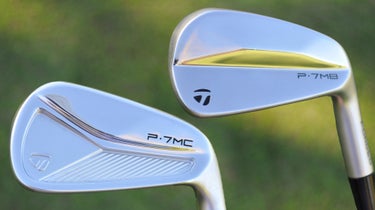
Be willing to “throw” the clubhead on the downswing and allow it to release.
getty images
Among the key weapons you need in your shotmaking arsenal: a high pitch shot that lands softly and doesn’t roll. While this shot has some risk to it, you can minimize the chance of mishits with good technique. Here’s how to pull it off:
1. Employ the shot sparingly
High pitch shots around the green are fun and beautiful when well executed, but because they require a longer swing relative to a chip, they’re a bit riskier. Hit the shot only when you need it.
2. Club selection matters
Club selection for high pitches isn’t always intuitive. You will not use a pitching wedge, because it doesn’t have enough loft and thus produces more carry than roll. Use a club with more loft and bounce, i.e., your gap, sand or lob wedge.
3. Have enough bounce
The rounded bottom of your gap, sand and lob wedge is designed to help the club will glide across the ground rather than dig in and get stuck. Many great new wedges have high bounce options. My new Ping glide 60-degree wedge has 14 degrees of bounce, and I really like the way the club interacts with the ground.
4. Set the club then yourself
When you set your clubhead behind the ball, you want to set the shaft in a more neutral position where the handle is not leaning toward the target. Set your club without any lean and then set yourself so that the club is centered with the clubhead in the middle of your heels and the end of the club pointing to your belly button.
5. Hit the ground
You need to be willing to hit the ground with your clubhead to get the ball into the air. Do not make an upward motion or “help” the ball into the air. Simply make your club hit the ground, and this will help produce a nice high soft shot.
6. Throw the clubhead
Be willing to “throw” the clubhead on the downswing and allow it to release so the shaft is more straight up-and-down rather than leaning forward at impact. This proper release for pitching will help increase the loft and bounce at impact.
7. You can use your wrists (but you don’t have to)
You may have heard you have to use your wrists to hit a high soft pitch, and while this can certainly help increase spin, it also increases the chance of unnecessary moving parts. If you use a lofted club and set up in a neutral set-up position and release the club properly, you can still hit a pro-grade pitch shot without using much hinge.
8. Smaller setup = smaller swing
For shorter pitches, it’s helpful to narrow your stance and grip down on the handle. This shorter lever will help to limit unwanted clubhead speed and distance. A narrower stance also limits your flexibility and helps you to make a shorter backswing.
9. Calibrate to where the ball lands
When you practice your pitches, focus more on how long of a backswing you need to land the ball different distances in the air. Knowing the distance the ball stays in the air is important because when you are hitting a lofted pitch you are generally needing to carry rough or a hazard. Club selection and backswing length will determine your carry distances.
10. Practice to build confidence
Pitch shots require practice because of the moving parts in the swing and the longer backswing required from a lofted club selection. Work on technique and solid contact. Then you can transition to working to targets and distance control. When I warm up on the range, I make a point to hit a few pitches before going to the course. A lofted pitch is a necessary shot for all complete golfers. Understanding what clubs you can use, the proper setup and motion will lead to smooth lofted shots and more up-and-downs.
Latest In Instruction
"Stop" - Google News
January 28, 2023 at 11:56PM
https://ift.tt/QYgZGrV
10 ways to hit high soft pitches that stop on a dime - Golf.com
"Stop" - Google News
https://ift.tt/fHxmIgV
https://ift.tt/2YfyPRN
Bagikan Berita Ini

















0 Response to "10 ways to hit high soft pitches that stop on a dime - Golf.com"
Post a Comment